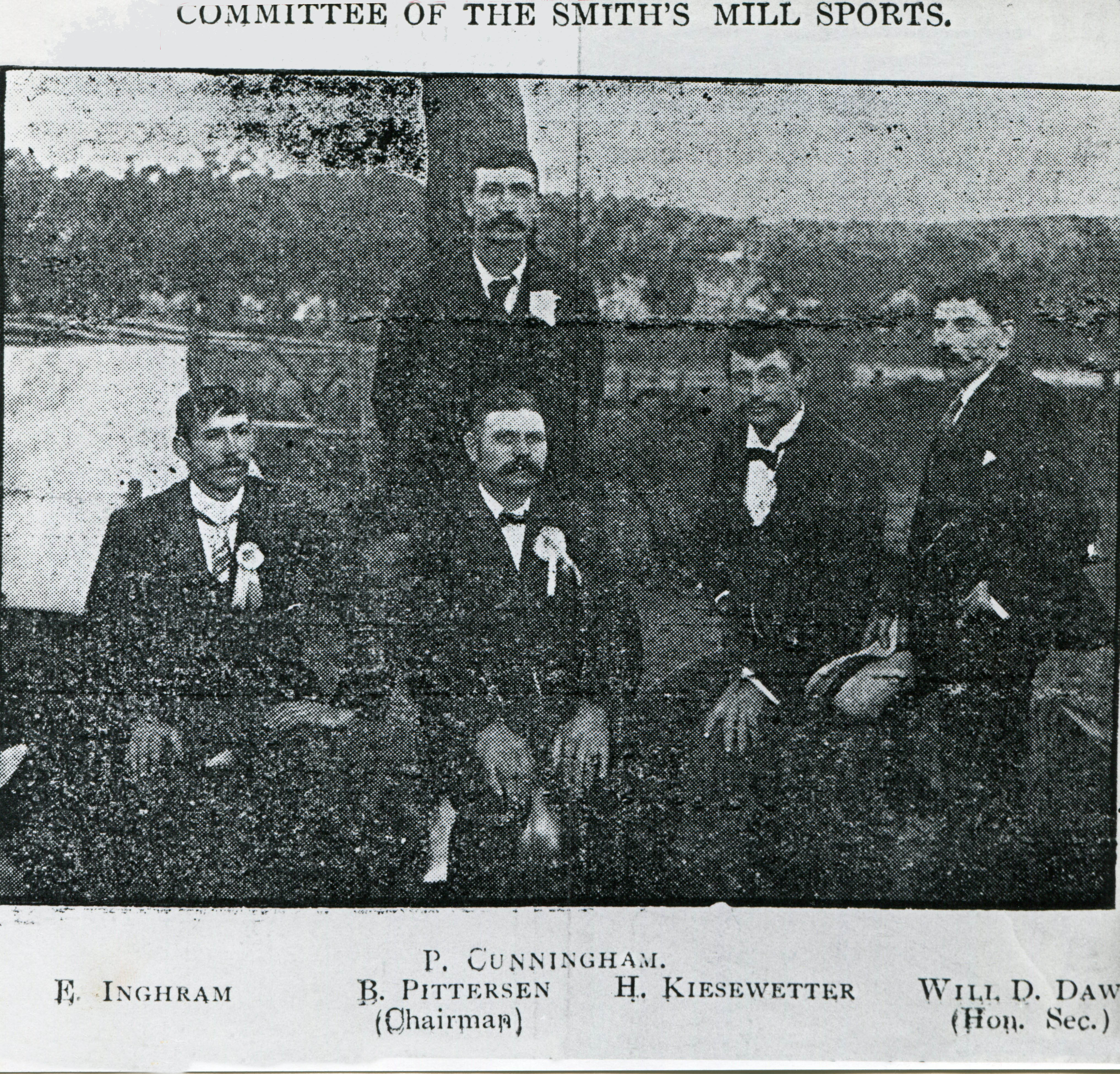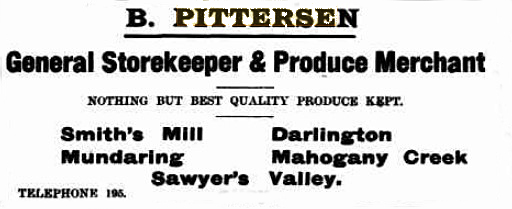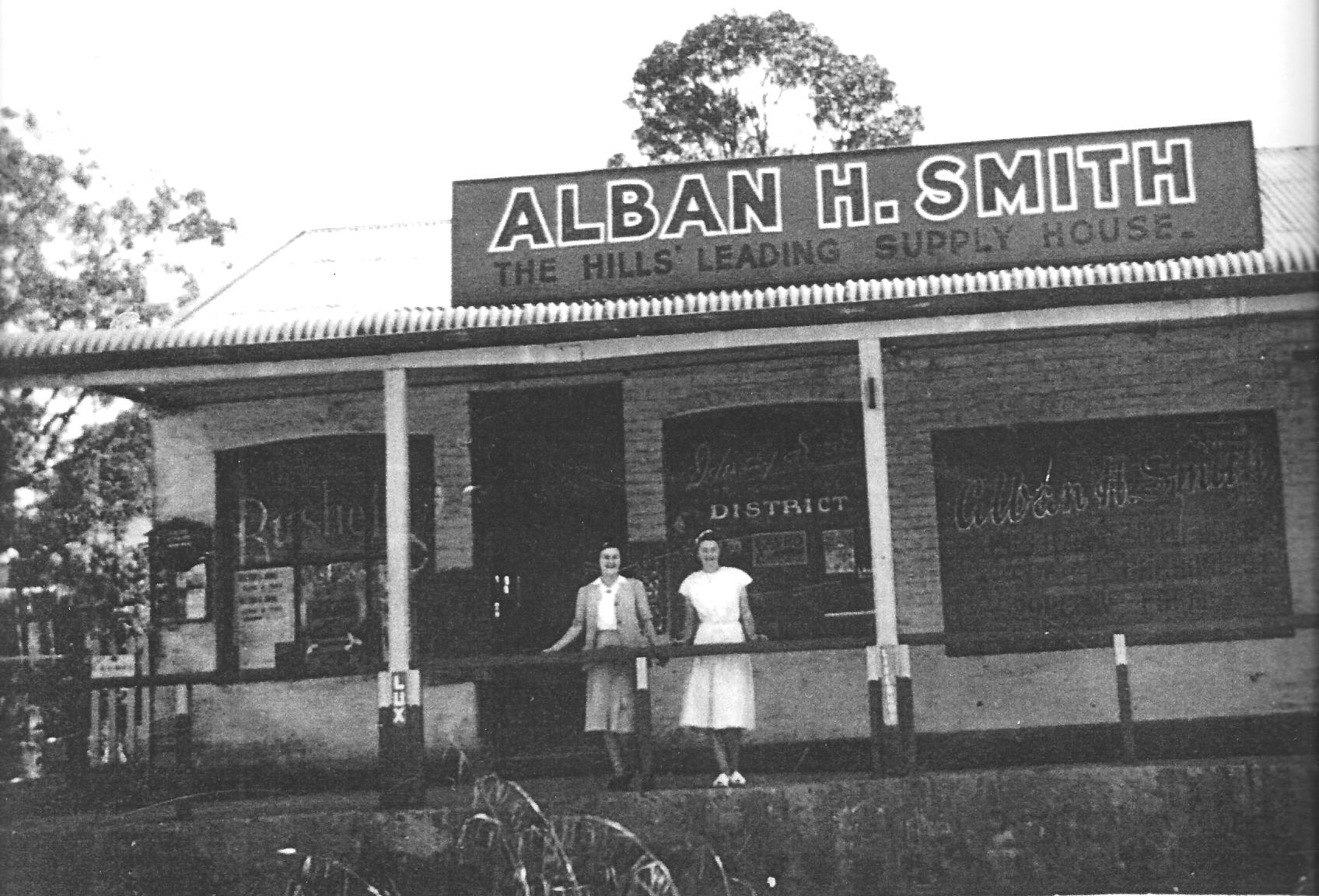PITTERSEN'S STORE - 3 RAILWAY PARADE.
Researched and written by Mary Richmond (with assistance from 'Mundaring: A History of the Shire'; and conversations with families of past owners), Lyn Myles & Rob Borsje.
When the railway line through Smith’s Mill was built in 1884 it serviced the timber, gravel, brick and fruit industries, and provided transport for the people then moving into the district to work in the jobs being created.
These jobs brought families to the area and by the 1890s Smiths Mill had become a village and the settlers needed shops to buy their day to day needs. There were no refrigerators in homes then, so foods like meat and butter had to be bought as needed, as they would only keep for a few days in a coolgardie safe or, in later times, an ice box.
There was a rough cart track running beside the railway line (which is now Railway Parade), and the first shops were built along the northern side. Early records show there were two butchers, three storekeepers, and for a time a ‘Draper and Cheap Cash Grocer’s’ shop.
At this time the little settlement near the railway line was reached by a track that left the York Road (now Gt Eastern Highway) near the present day Bilgoman Swimming Pool and meandered over and down the hill towards the railway station. McGlew’s ‘Springside’ property was the first watering place after leaving Guildford for the horses of the travellers going to York.
In 1896 one of the shops near the railway station was owned by Mr Ben Pittersen. He was born in Norway in 1865 and arrived in Victoria, Australia in the late 1800’s. Here he married a widow, Hannah Eliza Stribley (nee Herd) in 1891, who already had two sons: Thomas and Norman. Ben and Hannah had two more sons, Stanley and Harold, in Victoria before moving to WA, where in 1896 he purchased land at Smith's Mill and built his store. He was the storekeeper for about 25 years. Three of his sons; Norman, Stan and Harold, went off to fight in the First World War, however only Stanley survived the war and returned home, where he chose to rejoin the WAGR rather than help with his father’s store. Stan’s older half brother Thomas (Stribley) also worked for the railway in Glen Forrest, before marrying in 1911 and moving away.
Ben's wife, Hannah, died in 1918, and it was reported in the Swan Express of 5th April that year that “Her second son, the late Sergt.-Major Norman Pittersen, lost his life on Easter Saturday of last year, and it is generally conceded that his death was the beginning of the end of his mother's life”.
To expand his business, Mr Pittersen added a delivery service and advertised in the local newspaper to ‘supply with promptness and regularity all orders for Meat, Bread, and General Groceries and Stores to the residents of Smith’s Mill, Sawyers Valley, Mundaring, Mahogany Creek, Darlington and surrounding districts’(Swan Express 27/2/04).
Pittersen’s original shop was a wooden building. In 1920 he replaced this with a brick building which still stands today opposite Burkinshaw Road. Ben Pittersen’s contribution to the area was significant: he served on the first Smith's Mill Sport Committee as Chairman in 1902 (refer to the photograph below) and helped establish the sports ground, the Darling Range Football Assoc. (Chairman, 1902), and served on the Greenmount Road Board from 1903 to 1918 and again from 1919 to 1921, holding the Chairman’s position from 1908 to 1909. He briefly resigned from the Board in mid-1918 after the death of his wife in March 1918.
The reasons behind Ben’s death by suicide in July, 1921, one year after the store was rebuilt, are available here.
In the early days of Smith’s Mill/Glen Forrest the general store had to cater for the needs of the community at the time. Many families lived on a few acres with some fowls and ducks for eggs, a cow for milk, cream and butter, and maybe a vegetable garden. Those living on the outskirts of the village may have had a horse to pull their cart or their plough so there was a ‘produce’ section where bags of wheat, bran, pollard, chaff, blood and bone manure, superphosphate, seed potatoes and other farm supplies were stored. The floor of this section was higher than the main shop and opened onto the front verandah through the now blocked-off doorway where the delivery vehicles could drive under the verandah and be loaded or unloaded easily.
Self service supermarkets were unheard of until the late 1950s so most of the goods for sale were on shelves against the wall and behind a long counter. The customers asked the shopkeeper for the items or the weight required, the lady or man behind the counter took the items from the shelf, weighed or placed them on the counter, listed the prices on a piece of paper, added the total up the old-fashioned way, (no calculators and few cash registers then) and put the goods into a large paper bag, or a box, or the shopper may have brought her own basket or string bag. For large orders, the shopping list would have been left with the storekeeper and delivered later to the house.
After Ben Pittersen’s death in 1921, Robert Sanderson bought the property and it remained in his name until 1926, with the Rate Books noting him as a ‘grocer’. In 1926, Robert Sanderson was facing bankruptcy Sunday Times, 9 August, 1925, pp 2
NOTE: The store stood on Lot 4 of Swan Loc. 383.
TENDERS are invited and will be received by the undersigned up to 4 p.m. on FRIDAY, AUGUST 14, 1925, for the undermentioned ASSETS of the GENERAL STORE KEEPING BUSINESS at present carried on by Mr. ROBERT SANDERSON; at Glen Forrest:-
Lot 1 - Stock in Trade (approx) .. .. .. .. .. .. .. £80
Lot 2 - Plant, valued at (approx.) .. .. .. .. .. .. £100
Lot 3 - Sundry Debtors (approx) .. .. .. .. .. .. £250
Lot 4 - Freehold Land, consisting of Lot 1 on Deposited Diagram No. 1422, and being portion of Swan Location 383, and being all the land contained in Certificate of Title Vol. 228, Folio 149, on which is erected a weatherboard house and shop. Area: 27.8 perches; frontage, 113.6 links to Railway-parade, Glen: Forrest.
Lot 5.- Freehold Land, consisting of Lot 2 on Deposited Diagram No. 1422. and being portion of Swan Location 383 and being portion of the land contained in Certificate of Title, Vol. 566, Fol. 1. No improvements. Area, 36.4 perches; frontage, 113.5 links to Railway-parade, Glen Forrest.
Lot 6. - Freehold Land, consisting of Lot 3 on Deposited Diagram No. 1422, and being portion of Swan Location, 383 and being portion of the land contained in Certificate of Title Vol 566, Fol. 1. No improvements. Area, 1 rood 5 perches: frontage 113.6 links to Railway-parade, Glen Forrest.
Lot 7. - Freehold Land, consisting of Lot 4 on Deposited Diagram. No. 1422, and being portion of Swan Location 383 and being the whole of the land contained in Certificate of Title Vol. 233, Fol 8, on which is erected a brick house and shop, storeroom, tanks, stables, chaffhouse and cart sheds. Area, 1 rood 13.6 perches: frontage, 113.5 links to Railway-parade, Glen Forrest.
The business is in a good district, and should suit a man with reasonable capital. There is no opposition. The business is being carried on, and may be inspected any time.
Tenders will be subject to the usual conditions and must be accompanied by a deposit of 10 per cent. No tender will necessarily be accepted.
Further particulars may be obtained from the undersigned.
HAROLD COLVIN and CO.,
Public Accountants and Auditors.
28-23 A.M.P. Chambers, St. George's terrace, Perth. and the property was sold to Mr Ernest L.Stump. Ernest died in a motor vehicle accident on Great Eastern Highway in 1930, and his son, Eric, took over his father’s business in 1933 after Ernest’s estate was settled.
It was known as ‘Stumpy’s Store’ for the next 20 years until 1946 when Mr & Mrs Alban Smith came to Glen Forrest with their daughters May, Marjorie and son Peter.
The storekeepers lived in a house on the block beside the shop. It had a stone wall with a pointed brick top at the front (part of this is still in place near the Post Office), a large garden of lawn and rose beds, and three fish ponds, one in each section of lawn in front of the house. At the eastern side of the block was a tennis court. This was quite a grand garden for the times.
Over the years the needs of the shoppers changed and in the 1950s fewer people had cows and horses, though some still had their ‘chooks’, more people were employed outside the town, and Glen Forrest began to become more suburban.
Although stockfeed sales would have been reduced, the storeroom was still well used because many things came to the shop in bulk and had to be weighed into 1 lb (lb = pound in weight = about half a kilo), 2 lb, 5 lb or 10 lb bags. Potatoes, sugar and flour came in large hessian or cotton sacks, and Mills and Wares biscuits came loose in tin boxes, all needing to be weighed into household quantities as required. Pre-packaged goods came when grocery stores became self-serve around 1960.
The Smiths usually employed one or two young local girls to help in the shop and their children also helped. Orders of groceries or produce were delivered by Mr Alan Mack in a small truck that was often parked ready at the loading door.
As there had not been a liquor outlet in the town since the hotel closed in 1921, the Smiths saw an opportunity to expand their business and obtained a ‘gallon licence’.
(1 Gallon = 4.5 Litres) This licence allowed a grocery shop to sell a minimum of a gallon (6 bottles of beer or wine) to customers. This limited licence should not take business from hotels, though the nearest was about 5 kms away, but did give local people a place to buy supplies to take home.
In 1958 the Smiths sold the business to Mr & Mrs Ken Golding. They lived in the house at the rear with their daughter Rhelma and son Phillip and ran the business until 1966.
The business changed little under the Golding’s ownership, they sold general groceries, sweets and ice cream cones to the children walking home from school, newspapers, magazines, school supplies - pencils, pens, exercise books, Clag glue, etc, beer, wine and spirits and stock foods, and Mr Mack continued to deliver orders to homes.
The next owners of the store, which had originally been started by a European migrant in 1896, were also migrants from Europe. Mr & Mrs Peters and their children, Nonja, Eddie, Nancy and Eric, were Dutch migrants who came to Australia for a better life after World War 2. When the Peters took over the shop the style of the shop changed. A storeroom at the back was opened up to become the liquor store area, and later the ‘gallon’ restrictions were removed, groceries were in the middle, and at the front Eddie started a newsagency. The ‘general store’ had always sold newspapers, magazines, school supplies and greeting cards, but now the town was large enough to have a dedicated newsagent, and soon after a newspaper home delivery service began.
After a few years, the Peters moved out from the house at the back and it was converted into a restaurant known as ‘Churchills’. In 1979 the building was destroyed by fire and the Peters cleared the land and built three ‘log cabin’ style shops where the garden and tennis courts had been. Eddie moved the news agency into the first shop. the middle shop became the ‘Gourmet’ and the third had a number of varied uses. When these shops burnt down the present building was erected.
The next owners of the shop were Mr Peter Mols and Mr Ken Cooper who continued the business of Liquor Store and Groceries.
When Mr Phil Vellalonga, another European migrant, bought the property, then being the original store, the three log-cabin shops and the land behind, he extended the retail premises by adding the red brick building at the back of the block. This accommodated a new grocery store, and a liquor store and Mr Pittersen’s 1920 shop was converted into a restaurant, named by its various chefs as first, ‘Forresters’, then ‘Florentines’, ‘Smith’s Mill’, 'Caboose' and today (2020) it is the ‘Real Mountain Nepalese and Indian Restaurant’.
Scroll down for photographs. . .

Ben Pittersen (front, 2nd from left) the Chairman of the Smith's Mill Sports Committee, 1903. The man standing on the right is Will D. Dawson.
Source: Trove.

An advertisement in the 'The Democrat', 5th Nov. 1903 for Pittersen's Store.
The deliveries were all localities along the Smith's Mill railway line, suggesting that produce and goods were sent out by train.
Source: Trove.

Stump's Store advertisements, [L} 1938 and [R] 1933. E. Stump expanded and had stores in Parkerville and Mt Helena.
Source: Trove.

From 1946 to 1958 Alban Smith owned the store, as pictured here.
© Copyright Rob Borsje, Lyn Myles, Mary Richmond and attributed sources.